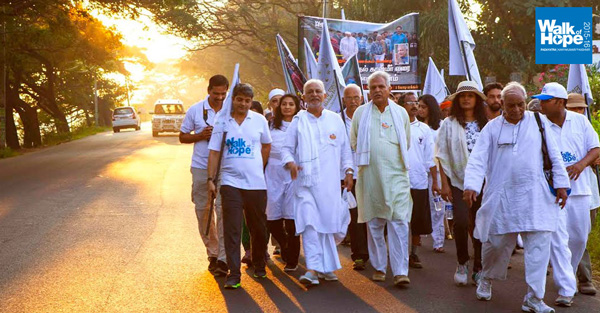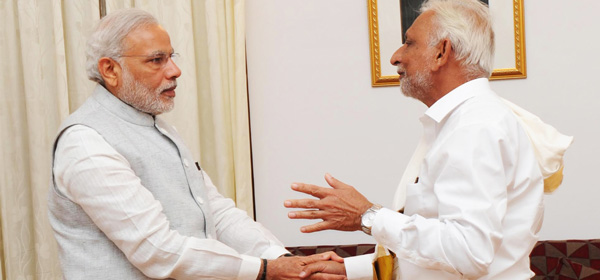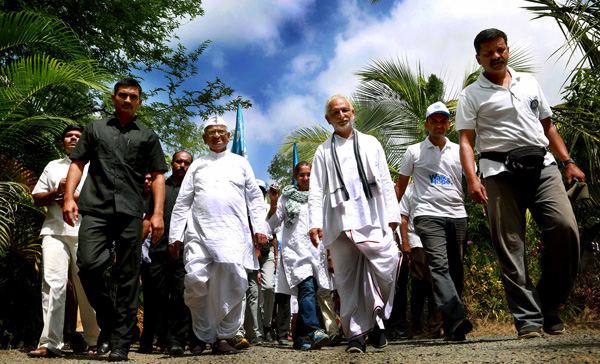Sri M: The man leading a 7,500-km walk for harmony

The initiative
- Spiritual leader Sri M is leading a group of 70 people on a 7,500 km-long walk from Kanyakumari to Srinagar
- The walk started in January this year. It is expected to take 500 days to complete
- It will pass through 86 districts across 11 states
- Walkers range between 19 to 80 years of age, and include corporates, professionals, politicians and academics
The purpose
- Communal harmony is the chief reason why this walk has been organised
- Sri M wants to spread the message of being human first, and all else later
- He says the objective is to start a dialogue that can defuse tensions
Kanyakumari to Srinagar in 500 days - on foot. This was the journey begun by a group of about 70 people at the beginning of this year. A padyatra of 7,500 kilometres, through 86 districts across 11 states, to promote peace and inter-faith harmony.
At the centre of this ambitious enterprise is one man: Sri M, a spiritual teacher revered by many as a yogi, a guru and a personal guide. The yatra was begun by and is led by him. At 66, he is walking nearly every day, every step of the way. His own story is fascinating. But more on that later.
Among the core group of yatris walking with him, the oldest is an 80-year-old retired Air Force commodore; the youngest a 19-year-old student of multimedia arts. The group is a fairly even mix of men and women, people from all over the country and some from outside it (including a Lithuanian lawyer), from a range of faiths and some with no avowed religion, from a variety of professions (including a former Karnataka DGP), with diverse motivations.
These people are, even now, walking from one end of the country to the other. They began on 12 January from India's southernmost point in Kanyakumari, and they hope to reach Srinagar sometime in April 2016.
Nearly every morning, starting at 5 am, the group walks 15-25 kilometres. And each evening, in remote villages or large cities, they engage local communities in an exchange about religious harmony. They seek to impart Sri M's belief that the diverse communities of India are united by a strong thread of spirituality, that people of all faiths are united in a common humanity.
An urgent cause
"We walk together," wrote Sri M in a mission statement published in The Huffington Post in May, "not as members of groups, faiths or parties, but as human beings. We walk together for a society where opportunity is given to all, regardless of caste, religion, language, region or gender."
Regardless of how you feel about Sri M's mission - or its spiritual bent - the Walk of Hope does have a certain symbolic power, particularly at a time when the threat of communal violence seems forever imminent. The dangers of a divided society are clear and present.
Across the country, 4,265 communal riots were reported between 2009 and 2014, in which 654 people died. Perpetrators of violence were rarely held accountable. Victims became refugees from their own homes. Countless lives and communities were disrupted.
Such disruptions are what concern Sri M most of all. When violence breaks out, he writes: "A stretch of peace and prosperity is suddenly arrested... Lives are lost and the social fabric is torn. The progress of the nation comes to a grinding halt. By the time things return to normal, our nation has lost crucial opportunities in all areas of development."
Starting at 5 am every day, the group walks 15-25 kms. Each evening they engage locals on religious harmony
"Simply by industrial action, the nation doesn't improve," Sri M told Catch. Speaking over the phone from Nirmal Pimpri village near Shirdi in Maharashtra, at around 9 pm on Day 191, he came across good-humoured, lucid and straightforward.
"I think we have become a little complacent. We don't see the dangers that can cause this nation to disintegrate. We only see a real threat when it comes to the surface, but underlying threats are always there. We have a nicely painted facade, but deep down, there are bombs ticking."
His Walk of Hope is an effort to address these dangers, heal social rifts - defuse these bombs, if you will.
How, you might ask. To some, the walk will seem little more than a symbolic exercise, a soft spiritual proselytising mission. What tangible effect can it hope to have?
A gesture of optimism
Sri M acknowledges that the walk is only a first step.
"The objective," he says, "is to start a dialogue." To start it in places where urban media debates about violence and secularism rarely go, and among people whose voices are rarely sought or represented.
In order to ensure the dialogue goes on, Sri M's Manav Ekta Mission is helping set up local groups along the way - "cutting across religion, caste and creed" - which will serve as anchors within their communities, continuing to work for inter-faith harmony.
Sri M's hope is that dialogue will serve as a preventative measure against violence. The idea is to "prepare people, so that when someone drops poison in their midst, they don't get instigated".
He holds that violence results from the instigation of insecure communities, usually for political ends. "I don't think India is, intrinsically, a violent nation," he says. "I think [religious violence] has to do with how religion is projected, and how politicians make use of religion.

Photo courtesy Walk of Hope
"Group identities are strong in India. When people are pressed into violence, it is because they feel threatened as a group - because they feel insecure. We need people to reassure them against that insecurity. I thought, to walk all over India, meeting people and talking to them - it could be preventative."
Geeta Betrabet, like many of her fellow walkers, believes in this approach: "If people have this idea in the back of their heads that we are all ultimately human, maybe they won't be instigated [to violence]."
"We don't know whether the hope will come to anything," Sri M concedes, "But does that mean you don't try?"
After 200 days on the road, walker Krishna Kulkarni, a trained engineer and former Managing Director of Panasonic India, asserts that "this is by far the most tangible effort for communal harmony I have witnessed in my lifetime." Others in the core group called it eye-opening, life-changing.
Overwhelming support
What the walkers have experienced along the way might be even more significant than the message they set out to impart.
The group is traversing a vast swathe of the country, much of it under-attended, remote not only in geography, but also in imagination. And it is doing so in the most intimate manner possible, walking, resting and eating among the people it meets along the way.
Most of the people Catch spoke to said a desire to see the country was one of their primary motivations for joining the walk, if not the main reason. And they have all found the journey illuminating, if not transformative.
Betrabet, 51, grew up in India. She now lives and teaches anatomy and physiology in the state of Wisconsin, in the United States. Having lived in two countries "affected by terrorism", she wanted to be part of a peaceful movement against it. She has known Sri M for 29 years through her aunt, to whom he is married, and calls him 'M', on his request.
She is amazed at the kind of support she has seen for the walk.
"An auto driver gave M Rs 100 - his earnings for the entire morning - saying he couldn't join the walk because he had to feed his family, but he wanted to support him. Little children will come up to give him fifty paise, one rupee. People on the highway will see the banner, stop their cars and cross to come and do pranam to M. It just shows the message is reaching people - everybody wants peace. I don't think there are any words to explain how I feel."
Pranav Kumar, who maintains a public log of the walk's progress, is similarly astonished at the support they have encountered. "We have been to every place of worship we could, and everywhere, we were welcomed with open arms. Even at very orthodox temples in Kerala [where there are usually strict restrictions on entry], people were standing outside with garlands."
Part of the walk's organising committee since before it began, Pranav says: "We were worried about how the funds would come about; how we'd manage the small things. Somehow, it's all fallen into place. And it's not because of donations by rich people. It's because of the common man giving what he can spare - a roadside fruit-seller offering us a basket of fruit."
Gandhi's great-grandson
"This is a country of very large-hearted people," echoes Kulkarni, "whether rich or poor." Kulkarni is 52, and happens to be the great grandson of Mohandas Karamchand Gandhi.
Kulkarni read Sri M's autobiography, Apprenticed to a Himalayan Master, in 2012. Thereafter, "I met with him, I liked him, and he became my teacher, my guru, whatever you want to call him."
For Kulkarni, the walk so far has been a journey of hope and frustration. "I have yet to walk across a single inch of land that is free of garbage," he laments. "This is not Bapu's India."
"I don't see swavalamban, swachhata, swechha, satyagraha. Satyagraha has become a verb. People think it means sitting in a protest. But satyagraha means satya ka agraha - to insist on the truth."
He has found, though, that a love for Bapu still endures. In one instance, two men over the age of 90 wanted to touch his feet. When he demurred, "they got angry with me! They said, 'it's not your feet I'm touching.' They just wanted to touch his flesh and blood."
Kulkarni never met his great-grandfather, but his grandfather Ramdas and mother Sumitra spent their lives in Gandhi's ashram. "I didn't see my Bapu," he says, "but for me, Sri M is living Bapu."
He has said as much at several gatherings and satsangs along the route of the padyatra.
The cross-country walk is a long-held dream of his, deferred for years owing to career concerns and the responsibilities of family life.
Now that he is finally walking, he finds his instincts on certain issues confirmed. "The women work," he says, "whether at home or in the fields, the women are always working. Everywhere I've been. You'll never see a group of women playing cards or gossiping in a chai shop. I never saw a man washing his own clothes, or his own utensils. Men are holding women back. This was my view, and it has been confirmed."
Kulkarni also says he has begun to understand what makes India one nation. "I have heard hundreds of people say we are one nation, but never why. I have almost come to a conclusion now. It is because there is a spiritual thread that runs through this nation. It is our spiritual heritage that ties us together."
Personal transformations
Pranav is 25, and was about to begin his PhD research in mathematics and computational biology in Denmark when he decided to get involved with the walk.
"I'm the kind who wanders," he says. "I felt it would be a nice chance to travel in a different way."
"I now feel this is a very powerful symbolic movement. In a time when all you read about is violence, here is a man who is speaking about love and compassion, peace and harmony. I'm sure it will be remembered."
Like every other walker Catch spoke to, Pranav feels personally transformed by the walk.
Not only did it turn out to be more physically challenging than he expected, it exposed him to realities he hadn't foreseen. "This is the kind of India you don't get to see in the city. Realities here are much more vast, and much more harsh."
As a result of this exposure, "the things that seemed very important before, don't seem that important any more."
By way of example, with a smile in his voice, he offers: "I liked motorcycles a lot." He had a classic 500cc Royal Enfield, which he loved but sold before the walk because there would have been no one to take care of it. "I wanted to get a bigger, better, faster bike" - something imported and expensive. "That seems pointless now."
Politicians like PM Modi, Union minister RS Prasad, and Congress's PJ Kurien and Karan Singh have supported it
It's not just bikes. Pranav feels he has come loose from "this mad run to have more and more." Things have slowed down for him, he says. "I'm enjoying life more."
This sort of transformation is, in fact, part of the stated point of the walk. As Sri M puts it, the inner journey is "the crux of this syncretic exercise to make India one country and humankind its citizens."
Political engagement
But surely individual reflection is only one part of it? Considering Sri M's own characterisation of communal discord and violence in the country as being politically fomented, some engagement with the political and religious establishments would seem imperative.
The walk's organisers do seem to have reached out to leaders from across the country, religions, and the political spectrum. Present at the flag-off ceremony in Kanyakumari were Ravi Shankar Prasad, BJP member and Union Minister for Communications and Information Technology, and Karan Singh, senior member of the Congress party and Rajya Sabha MP.
Congress leader PJ Kurien, currently deputy chairman of the Rajya Sabha, gave the movement full support and walked a stretch with the group through Kerala. Several MPs and MLAs, too, have expressed support by walking with the group.

Photo courtesy Walk of Hope
Sri M met with Prime Minister Narendra Modi in Bangalore in April and briefed him about the yatra. Modi is reported to have expressed support.
What weight do such endorsements have? Especially considering they come from the very people and parties who are known to use communal divides and violence to their advantage, if not stoking them outright.
"The purpose of this walk is to reach the people," says Kulkarni, "it is to weld. It is not to spotlight aberrations and to amplify them."
Pranav agrees: "Change comes from social pressure; politicians will have to listen if people speak." Plus, he says, of the "hundreds of politicians" who have expressed support for the walk, "we cannot say who has instigated what".
Politicians apart, the Walk of Hope got a full-throated endorsement from Anna Hazare when the group passed through Ralegan Siddhi.

Anna Hazare joined Walk of Hope. Photo courtesy Walk of Hope
The man behind the mission
More than political engagement, what many of the walkers and organisers feel is needed is a greater degree of interest from the media.
PN Shanavas, who divides his time between his role as walker and as convener of media and communications for the Walk of Hope as a whole, says he has had some trouble generating interest for the walk in the national media.
This could have something to do with a general scepticism regarding spiritual movements at large. Considering the 'spiritual men' most often heard of in the news - Baba Ramdev, Asaram Bapu and so on - it's hard to imagine one with a sane mission and a sober manner.
"I will run from a guru a thousand miles," says Kulkarni, "I have never been to a guru in my life. But this man is different."
Indeed, if he is not more widely known, it is probably because he seems quite sane, and evidently committed to the ideals he propounds.
Sri M's Satsang Foundation runs three free schools and a public health centre in and around Madanapalle, Andhra Pradesh, where he also lives.
He has an interesting origin story too. Or, as he puts it, "I'm a weird mixture of various things."
He was born Mumtaz Ali (that's still his name on all official documents) to a Muslim family in Thiruvananthapuram. His Pashto-speaking ancestors came south as bodyguards to the Maharaja of Travancore.
When he began seeking his spiritual truth in Hindu scripture, his parents were supportive. "They were not so orthodox," says Sri M. "I had some problems with the community, but [my parents] were brave enough to stand by me, and I was courageous enough to face it."
He found his guru in Maheshwarnath Baba, with whom he spent a number of years in the Himalayas. He also spent a number of years living and working with the Ramakrishna Mission, with which he still maintains a close relationship, and the Krishnamurti foundation, where he met his wife, with whom he has two kids.
He learned a lot from the two iconoclasts behind those two institutions. Swami Vivekananda and J Krishnamurti were both "a necessary part of my spiritual evolution", he says, though he doesn't always agree with the latter. "He was always against tradition of any kind. But what if a tradition is good? You can't throw it out just because it's tradition. That's like throwing the baby out with the bathwater."
On the other hand, he says, "I find it very difficult to fit into a structured religion, because you must first believe. Whereas I think exploration and inquiry must come first, and inquiry starts without belief."
It is odd to hear such sceptical talk from a man described as a spiritual leader, a guide, a yogi. But perhaps that's because we are too used to encountering ideologues who project 'spiritualism' to disguise a parochial orthodoxy.
Sri M seems pretty freewheeling in comparison. His spiritual practice is rooted in teachings of Hindu scripture, but at many of the satsangs held along his journey, he quotes from the Quran, too.
Satsang can have many interpretations. His version: "people sit together, talk, discuss, meditate and find the reality. This is what I mean by satsang." He propounds this collective practise over the individual yoga techniques he inherited from his own master.
It should come as no surprise that his life's mission is "to bring people together". The Walk of Hope, too, is an extension of that mission.
"Mainly, my life's mission is what Kabirdas left undone," he adds. It is fitting, then, that one of his companions on the walk has been Prahlad Singh Tipaniya, whose music is perhaps the perfect accompaniment to this improbable story.
First published: 25 July 2015, 2:46 IST





![BJP's Kapil Mishra recreates Shankar Mahadevan’s ‘Breathless’ song to highlight Delhi pollution [WATCH] BJP's Kapil Mishra recreates Shankar Mahadevan’s ‘Breathless’ song to highlight Delhi pollution [WATCH]](https://images.catchnews.com/upload/2022/11/03/kapil-mishra_240884_300x172.png)

![Anupam Kher shares pictures of his toned body on 67th birthday [MUST SEE] Anupam Kher shares pictures of his toned body on 67th birthday [MUST SEE]](https://images.catchnews.com/upload/2022/03/07/Anupam_kher_231145_300x172.jpg)






